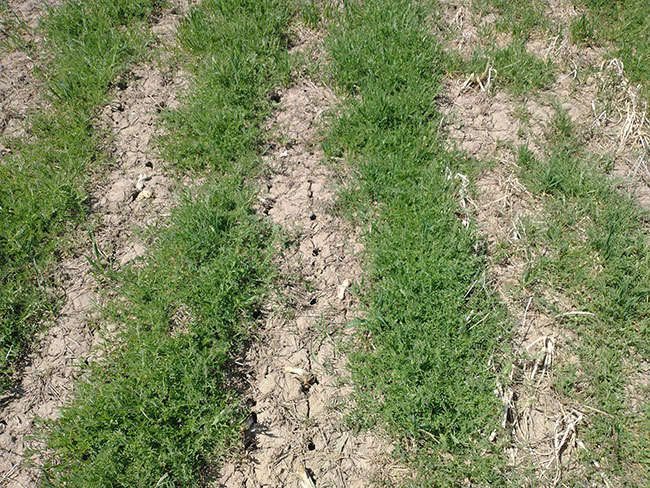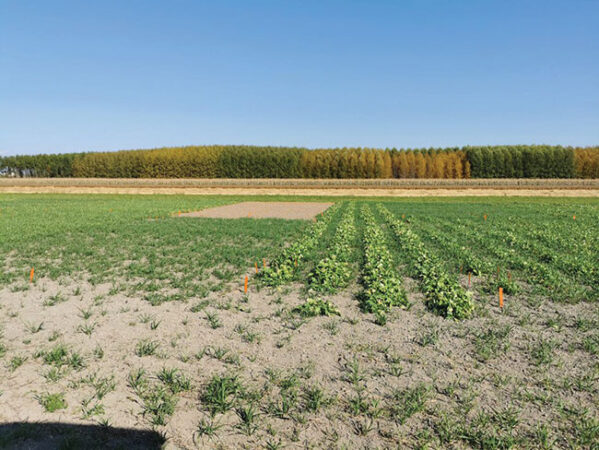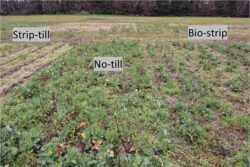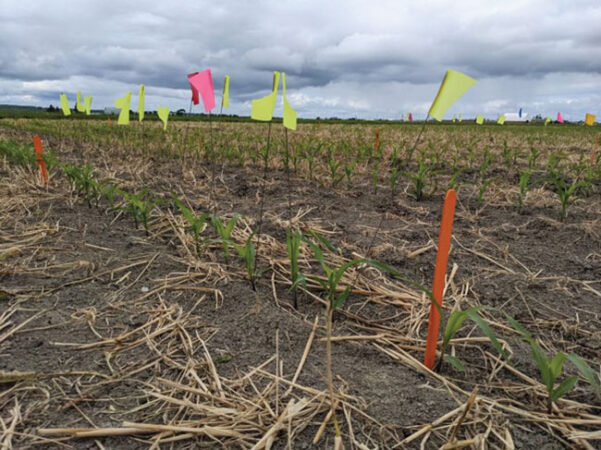
Features
Cover Crops
Tillage
Let your cover crop do the tilling?
Comparing bio-strip tillage and other approaches for preparing a seedbed for corn.
March 11, 2024 By Carolyn King
 Radish bio-strips with cereal rye wheel track strips, in the spring before corn planting.
Photos courtesy of Joshua Nasielski, University of Guelph.
Radish bio-strips with cereal rye wheel track strips, in the spring before corn planting.
Photos courtesy of Joshua Nasielski, University of Guelph. A few Ontario crop growers are using an intriguing practice called bio-strip tillage to prepare a good seedbed for their next crop. Instead of using mechanical strip tillage, they plant certain cover crop species that produce a similar – or perhaps better – strip for planting.
To provide more information for farmers interested in this practice, two Ontario researchers are comparing bio-strip tillage with other tillage and cover crop options and assessing the effects on corn yields and the bottom line.
“As researchers, we can play a role by measuring the effects of different cover crops in the same environment to see how we can optimize the system. Because we have small plots, we can do direct comparisons with strip tillage versus no-till versus bio-strip tillage,” explains Laura Van Eerd, who is leading this project. She is a professor of sustainable soil management at the Ridgetown Campus of University of Guelph.
This project, which is just wrapping up, has nine site years of data. The field experiments took place at three Ontario crops research centres: Ridgetown, in southwestern Ontario; Winchester, in eastern Ontario; and New Liskeard, in northern Ontario. The sites encompass a range of soil and climate conditions and provide a look at some of the challenges of cover cropping in areas with relatively short growing seasons and clay soils.
The co-lead on this project is Joshua Nasielski, an assistant professor who heads the University of Guelph’s Northern and Eastern Ontario Agronomy Research Group. Van Eerd and Nasielski are also collaborating on a related project to evaluate a wide range of cover crop species and mixes to see which options work best in Ontario.
Bio-strip tillage basics
Nasielski explains that bio-strip tillage systems involve alternating strips of cover crop species that will produce a nice seedbed and different cover crop species that will make a good wheel track.
For the strip where the crop will be planted in the following spring, the idea is to plant cover crop species that grow quickly in the fall and provide some erosion protection and some benefit for soil structure. Just as important, the bio-strip cover crops also need to be species that are winterkilled and have residues that break down quickly, leaving a relatively bare strip by spring planting time.
Compared to a no-till overwintering cover crop, this bare strip may have better soil aggregation, warm up faster and enable a more uniform planting depth. Those effects could contribute to better germination and emergence of the following crop, which could improve yields.
For the wheel-track strip, the idea is to plant high-residue overwintering cover crops that are terminated with a herbicide in the spring. These cover crops provide well-known benefits such as reducing soil erosion, building up organic matter, enhancing soil microbial life and suppressing weeds.
Farmer experience indicates that, compared to bare soils, overwintering cover crops seem to dry the soil a little faster, allowing a farmer to get on the land a little earlier, and have better trafficability.

Some of the treatments in the fall. The plot in the centre has a radish bio-strip where the corn will be planted next spring, with cereal rye for the wheel track.
Plot comparisons
In this bio-strip tillage project, the cover crops were planted in the first half of August, shortly after winter wheat was harvested from the plots. Corn was then planted the following spring.
The trials compared five overwintering treatments: cereal rye; hairy vetch; a cereal rye/hairy vetch mix; a cereal rye/hairy vetch/kale/sunflower mix; and a no-cover-crop control.
The researchers chose cereal rye as an economical overwintering cereal that grows well in cool conditions and produces a strong root system. Hairy vetch is an overwintering legume that tolerates cold conditions. Kale is a biennial Brassica with very good frost tolerance. Sunflower, although it doesn’t overwinter, was included to further increase diversity.
Within these overwintering treatments were four tillage treatments: no-till, where the corn was seeded directly into the terminated overwintering cover crop; fall strip tillage, where a strip was tilled into the overwintering cover crop in the fall; bio-strip tillage with radish; and bio-strip tillage with a radish/faba bean/oat/buckwheat mix.
“When we conducted a preliminary bio-strip tillage experiment on a sandy loam soil, we put out a call on Twitter to ask growers what they were using in their bio-strip mix. From there we selected our cover crop species based on what we expect these cover crops to do,” explains Van Eerd.

Comparing three cover crop treatments in the spring before corn planting.
They chose radish because its large taproot could help in reducing soil compaction in the seedbed. Also, radish grows quickly in the fall and decomposes quickly after being winterkilled. They included faba bean because it is an annual legume and its residue breaks down quickly. Oat is an inexpensive cereal that grows well in cooler conditions. Buckwheat is a fast-growing broadleaf known for improving soil tilth; however, it sets seed very quickly, so volunteer buckwheat is something to watch for.
All cover crops were planted in narrow rows. For the bio-strip treatments, the project team planted two rows of the bio-strip cover crop alternated with two rows of the overwintering cover crop.
The team also tried putting a bio-strip into red clover that had been underseeded to winter wheat, just to see how that might work. However, it didn’t work; the red clover took over.
The overwintering cover crops were terminated with a herbicide just before or just after corn planting. The nitrogen rates on the corn were slightly below the recommended rates, to help in detecting if the cover crop legumes were providing a nitrogen credit to the corn.
The key parameters measured in the plots were corn growth and yield. “We mainly used the corn plant as a proxy of how suitable the seedbed was,” says Van Eerd.
“We looked very closely at emergence. That involved going into the field each day at the same time and placing flags to identify each corn plant that had emerged. We did that every day for however many days it took for the corn to emerge. So, we knew when each specific plant emerged and could follow it in terms of competition with neighbouring corn plants. Farmers know it’s best if all the plants emerge at the same time; if a corn plant is late to emerge, then it has to compete with its big brothers.”
The team also measured cover crop characteristics, such as stand counts of the different species. “Let’s say you’re planting a four-species mix and you intend to get a stand with 25 per cent of each, based on your seeding rate. However, growing conditions may favour some species over others. So, at the end of the day, the stand might be composed almost entirely of only one or two species,” Nasielski explains. “We also measured cover crop biomass in the fall and spring because a cover crop with a higher biomass will provide greater benefits.”
In addition, the team measured soil strength in the wheel track and the seed row, as well as things like soil temperature and uniformity of planter seeding depth.
Some initial results
Although they are still analyzing the data from the project’s final year, Nasielski and Van Eerd have some preliminary comments on what they have been seeing.
“The exact results varied a little between our sites and years. But a couple of things stand out to me,” says Nasielski.
“One was that, based on five site years of data, the tillage treatment – no-till vs. bio-strip till vs. fall strip tillage – didn’t have a large effect on corn yields.”
Nevertheless, the corn emergence data suggest big differences in seedbed quality between some of the treatments, even though that didn’t translate into yield differences. For example, with a cereal rye cover crop, the emergence percentage within a three-day window across the three tillage treatments was: no-till, 74 per cent; strip till, 82 per cent; and radish bio-strip till, 91 per cent. With a no-cover-crop control, it was: no-till, 93 per cent; strip till, 96 per cent; and radish bio-strip tillage, 90 per cent.
Van Eerd adds, “One thing to note is that we have set up our planter to create an excellent seedbed for the corn; for instance, we have trash whippers. And we plant when soil conditions are right. So, we’re taking care of basic agronomy that favours corn yield. That is probably one reason we didn’t see a difference between the bio-strip till and the strip till systems.”
The bio-strip cover crops produced more fall biomass than the overwintering cover crops, which was expected. The amount of spring growth among the overwintering cover crops depended on the site and year.
For the most part, the different overwintering cover crop treatments did not significantly affect corn yields, producing yields similar to the no-cover-crop treatment. Interestingly, in some years at Ridgetown, the hairy vetch cover crop was associated with significantly increased corn yields, especially compared to the no-cover-crop control. Nasielski thinks this yield increase could be due to a nitrogen credit from the legume.
“For our eastern and northern locations, growing cover crops was a big learning curve for the technicians and myself,” notes Nasielski. For example, in the first year, they found that the cool spring conditions at these sites tended to reduce the efficacy of glyphosate for terminating the cover crops. As a result, the overwintering cover crops weren’t completely killed and were able to compete with the corn plants, lowering corn yields compared to the no-cover-crop control.
So, the team switched to glyphosate plus dicamba or glyphosate plus Acuron (S-metolachlor, bicyclopyrone, mesotrione and atrazine). He says, “After that, we didn’t see any significant corn yield reduction with our overwintering cover crops compared to our no-cover-crop control, across all our tillage treatments.” Van Eerd adds that bio-strip tillage in red clover might be worthwhile if the red clover stand is poor after wheat harvest. “However, if you have a decent amount of red clover, then just go with that system because it works very well.”
The soil strength measurements indicate that an overwintering cover crop like cereal rye provides good trafficability. Nasielski says, “Cereal rye roots are like rebar for the soil. The difference in soil strength between the cereal rye strip and the bare bio-strip was astounding.”
Although the researchers haven’t analyzed the economics yet, Van Eerd says, “Most of the time, the bio-strips were equivalent to the strip tillage [in terms of corn yields]. So, bio-strip tillage is saving a pass in the field, which saves on fuel, time, and wear and tear. My guess is the strip tillage costs would cover the bio-strip tillage costs of seed and planting the cover crop.”

The project team used flags to closely track emergence and growth of individual corn plants in the different treatments.
A few tips for shorter-season areas
Based on the results so far, Nasielski has some tips for growers in eastern and northern Ontario who are thinking about trying cover crops and bio-strip tillage.
Regarding overwintering cover crops, you may need to mix glyphosate with another herbicide to ensure effective cover crop termination in cool spring conditions. Also, cereal rye may not survive the winter in northerly locations, and when it does survive, it may not come back very quickly. And warm-season species like sunflower probably won’t do well.
For bio-strip cover crop species, he recommends daikon radish and oats, which both grow well in cool temperatures. “At our northern Ontario location, radish was the most consistent and best performing species in terms of fall biomass. We are already doing some on-farm work with radish.”
One caution is that radish is a Brassica like canola, a common crop in northern Ontario rotations. “Some farmers are wondering about how having radish in their cover crops might relate to the risk of canola diseases, especially clubroot. I’ve talked about this with Mary Ruth McDonald, a professor at the U of G who has done a lot of clubroot research,” Nasielski says.
“She evaluated a number of different cultivars of daikon radish. None were completely resistant but most were strongly resistant. At this point, we don’t know if radish cover crops will contribute to clubroot inoculum buildup or, alternatively, reduce resting spore counts by stimulating germination of the spores and then preventing the pathogen from completing its life cycle, since the plant will die fairly soon in the fall.” Further research is needed to assess this issue.
Is bio-strip till for you?
“Overall, bio-strip till seemed to work equally well at all three locations. In the spring, it was always really apparent where the bare bio-strip was and where the wheel track was,” says Nasielski. “For people who want to integrate cover crops into their cropping systems, bio-strip till is something to think about.”
Van Eerd notes that the data from the three sites indicates the need for site-specific recommendations regarding things like how much cover crop growth to expect and how much it will benefit the corn crop. “We will be creating both general, provincial recommendations and regional recommendations.”
She adds, “Using a cover crop to prepare your seedbed is a pretty novel idea, and for some farmers, bio-strip tillage will resonate. However, adding cover crops into your cropping system requires proper management. It requires terminating your cover crop in a timely fashion and dealing with crop residues. It needs to be part of a plan.” And it usually requires some experimentation with different cover crop species and other components of the system to see what works best for your own situation.
“We’re not saying that one approach is bad and the other is good,” Van Eerd emphasizes. “We’re just evaluating different approaches to see what growers might take away that would work in their own system. We are identifying some of the risks for farmers who haven’t tried cover crops or are new to cover crops. For those who are already cover cropping, we are testing lots of options and we may be able to provide some recommendations about which ones to use or not use.”
This project is funded by Grain Farmers of Ontario and the Ontario Agri-Food Innovation Alliance, a partnership between the University of Guelph and the Ontario Ministry of Agriculture, Food and Rural Affairs (OMAFRA). Pioneer-Corteva donated corn seed. Graduate students working on this project included Farzana Yasmin and Victoria Snyder. Technical support was provided by Sean Vink, Holly Byker, Melinda Drummond, Ian DeShiffart, Ben Melenhorst and Nathan Mountain. OMAFRA’s Ian McDonald and Anne Verhallen helped with thinking through the project design at the Winchester and New Liskeard locations.